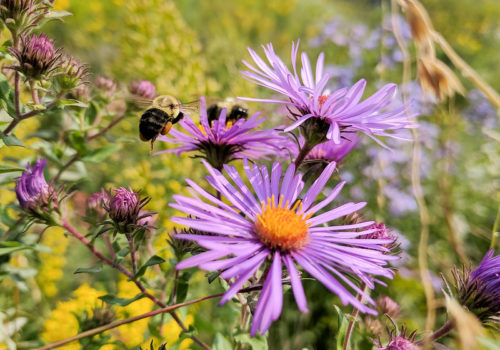News / April 10, 2019
Using Science and Engineering to Clean Up Downtown Minneapolis’ Dirty Stormwater Runoff


It’s spring, one of our dirtiest times of year in the stormwater management world. It’s the time when all that trash and pollution that gathered on the landscape and got buried under the snow starts to re-surface. Melting snow piles and rain mobilize that pollution, often before the street sweepers or other spring clean-up efforts can get out to address the problem.
For the past couple of years, the MWMO has been partnering with the University of Minnesota’s Bioproducts and Biosystems Engineering Department to look at the concentrations of pollutants that come off our landscape during different seasons, including spring. The work started under our 2018 Analysis of Runoff from Impervious Surfaces in Downtown Minneapolis (a.k.a. “Downtown Runoff Study”), which focused on monitoring pollutant contributions from four different impervious land use types in downtown Minneapolis: streets, sidewalks, parking lots, and rooftops. The field work for this study was completed between the fall of 2017 and spring of 2018. We recently posted the final report on our website.
What We Learned from the Downtown Runoff Study
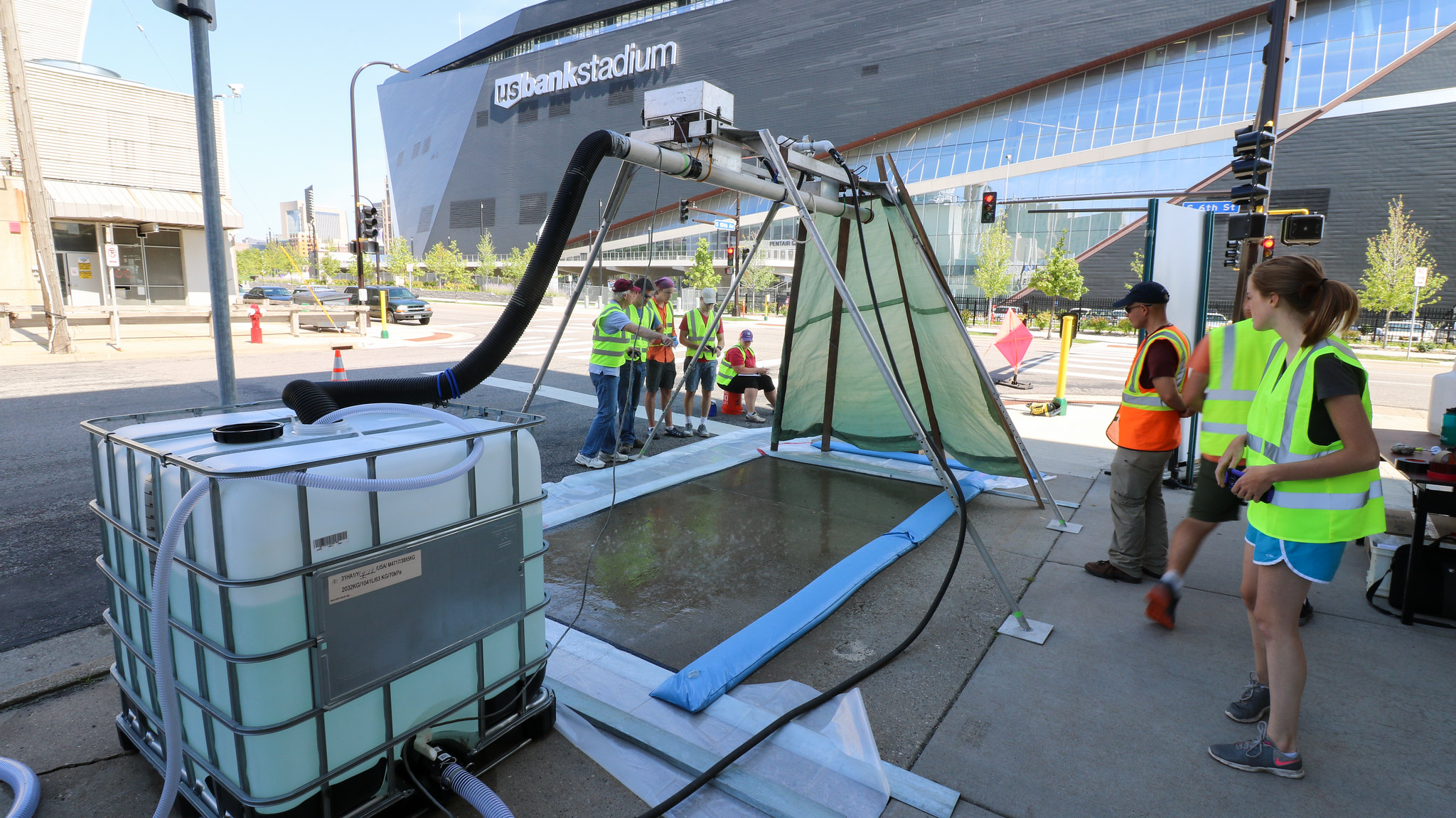
The study was focused on downtown Minneapolis, due to the large amount of impervious surface present there. Recent work by our capital projects intern, Jackie Seamans, showed that the downtown Minneapolis area is more than 90 percent impervious. Approximately 45 percent of the area is covered in rooftops, while 14 percent is parking area (lots and ramps). Impervious surfaces generally contribute more pollution to our urban waterbodies, so the focus of our study was to observe the concentration of pollutants coming off of the various surface types and use that information to help guide MWMO’s efforts to mitigate that pollution in the downtown setting.
Sampling pollutant concentrations in an urban setting is no easy task, and setting up a sampling routine in downtown Minneapolis is even more complex. But, through much work and perseverance, we got our data. The researchers tried to control as many environmental factors as they could — using a rainfall simulator to reduce the impact of variability in rainfall events, for example. However, it’s impossible to control all the environmental factors, and data like this has a lot of natural variability to it. The study resulted in thousands of data points. During some sampling events, sidewalk pollutant concentrations were higher than parking lots; at other times, parking lots were higher. Often, it depended on which pollutant we were considering.
That being said, amid all the data, there were some interesting patterns that could be identified:
1. Pollutant concentrations are highest in spring.
This isn’t necessarily a surprise, but having data that verifies these differences can definitely be helpful. High spring concentrations were particularly notable for chloride and sediments. The average chloride concentration observed at the parking lot sites sampled in the spring, for example, was 9 mg/L; while the average in the fall was 0.6 mg/L. Chloride concentrations from streets were found to be higher than sidewalks or parking lots. Interestingly enough, differences between summer and fall pollutant concentrations from the various surfaces were relatively minor.
2. Rooftops can be dirty sometimes.
We typically tend to think that runoff from rooftops is cleaner than (or at least as clean as) streets, parking lots or sidewalks. The results of our study did confirm that this is generally the case, but in some instances we saw higher pollutant concentrations coming from rooftops than the ground sites we sampled. One example of this was for bacteria concentrations, which were higher on rooftops, and tended to be higher in the spring.
3. The first flush of stormwater is dirtier than the average over an event.
The “first flush” is the initial burst of runoff during a rainstorm. Assuming the rainfall is intense enough to pick up pollutants and move them along with the water, the initial portion of runoff is typically the dirtiest that we see in the field. This is why engineers try to design systems to, at a minimum, capture and treat this first flush water. A limited number of first-flush samples were taken during the Downtown Impervious Surface Runoff study, but those that were showed that that portion of the runoff was typically significantly dirtier than the rest of the event.
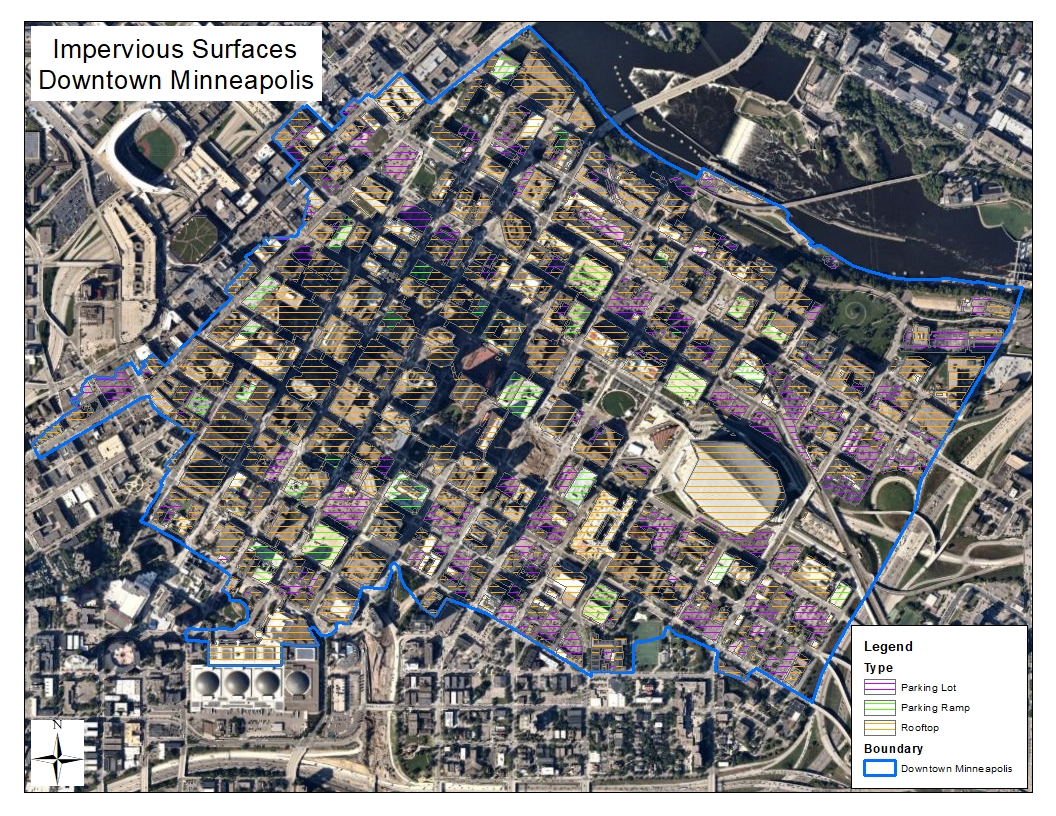
If you want to see all the details of our findings, you can find them in the report. It’s important to note that the results of this study represent a limited data set, and it’s hard to make any definitive statements based on the data, but we do see some trends that are interesting to explore and have unearthed some new questions to continue digging into. We’re continuing to partner with the University of Minnesota team to explore different sampling techniques downtown, and have been sampling rooftop runoff at other MWMO sites. In the meantime, we are working to find ways to use the results of our 2017/2018 work.
Treating Stormwater Runoff in Downtown Minneapolis
In addition to more data collection, the MWMO is actively working to plan and implement stormwater management projects in downtown — projects that will capture and clean up some of the pollutants observed in the study.
For the past few years, we’ve been working closely with the Downtown Improvement District (DID) and the City of Minneapolis to identify opportunities to install green infrastructure along downtown city streets. This infrastructure would be located in city right-of-way (just behind the curbline), capturing and treating runoff from the street. Based on last year’s study, some of the most polluted runoff that we see downtown is concentrated in these areas.
Given that this is not currently a common practice in downtown, the initiative was set up as a pilot project. All the partners came together for the planning, and MWMO led the feasibility work and committed to funding and monitoring the performance of these practices, should they be installed.
The partners considered a number of potential projects over the past few years, but finding locations that allow meaningful stormwater management to occur was a challenge. Balancing the desire for water quality improvements with all the other things that happen on and around downtown sidewalks — vehicles, bikes, pedestrian traffic, and utilities (which are often buried right behind the curbline) — is challenging. However, the South 8th Street Reconstruction Project provided a suitable opportunity.
In this case, the road reconstruction project was already planning to widen the sidewalks, pulling the curbline out into the roadway and minimizing any utility conflicts. This extra-wide sidewalk also afforded the space to consider stormwater management without conflicting with pedestrian needs. The City of Minneapolis transportation design team was already planning to install large vegetated beds as part of the streetscape and was willing to work with us to consider swapping some of these out for stormwater planters.
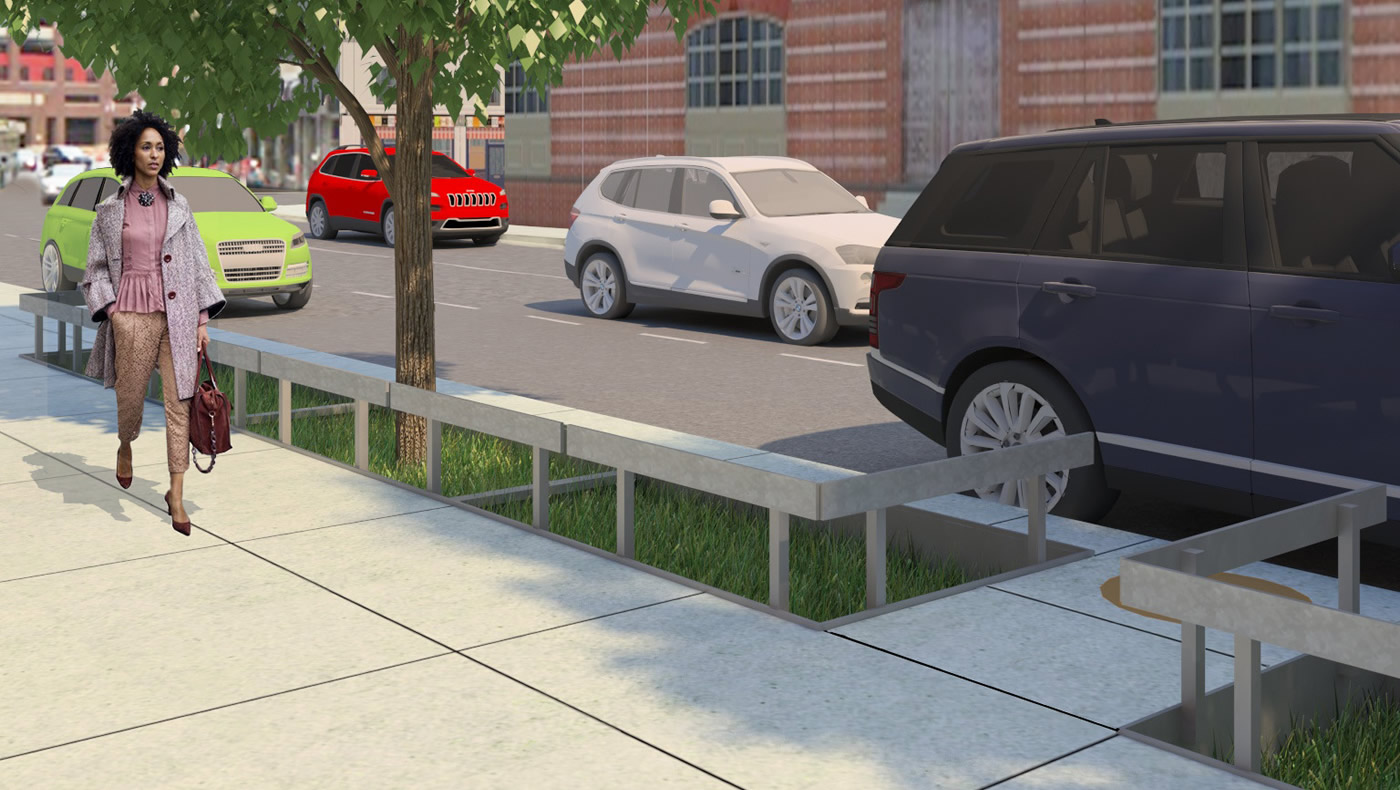
In partnership with Barr Engineering, the MWMO worked with staff from DID, the City of Minneapolis, and Alliant Engineering to prioritize one block for the stormwater planters. Given that this is a pilot project, we wanted to start small for now. The design calls for five stormwater planters — large bioinfiltration basins with recessed soils to allow space for stormwater to pond before it infiltrates. The planters will capture and treat runoff from South 8th Street from 5th to Portland Avenues, along with the alleys and sidewalks that drain to it. Initial estimates are that we’ll remove more than 200 pounds of total suspended solids and one pound of total phosphorus each year; however, we anticipate those numbers will be higher, and MWMO will eventually be monitoring the planters to see how they perform.
In addition to their performance, the stormwater planters are designed to be aesthetically pleasing and modular in nature. If they prove successful, the MWMO and DID would like to see more of these installed downtown. The modular design allows for easy replication in other areas, if those opportunities arise. Each of the planters will contain trees and sedges, which assist with infiltration and treatment of the stormwater that drains into them.
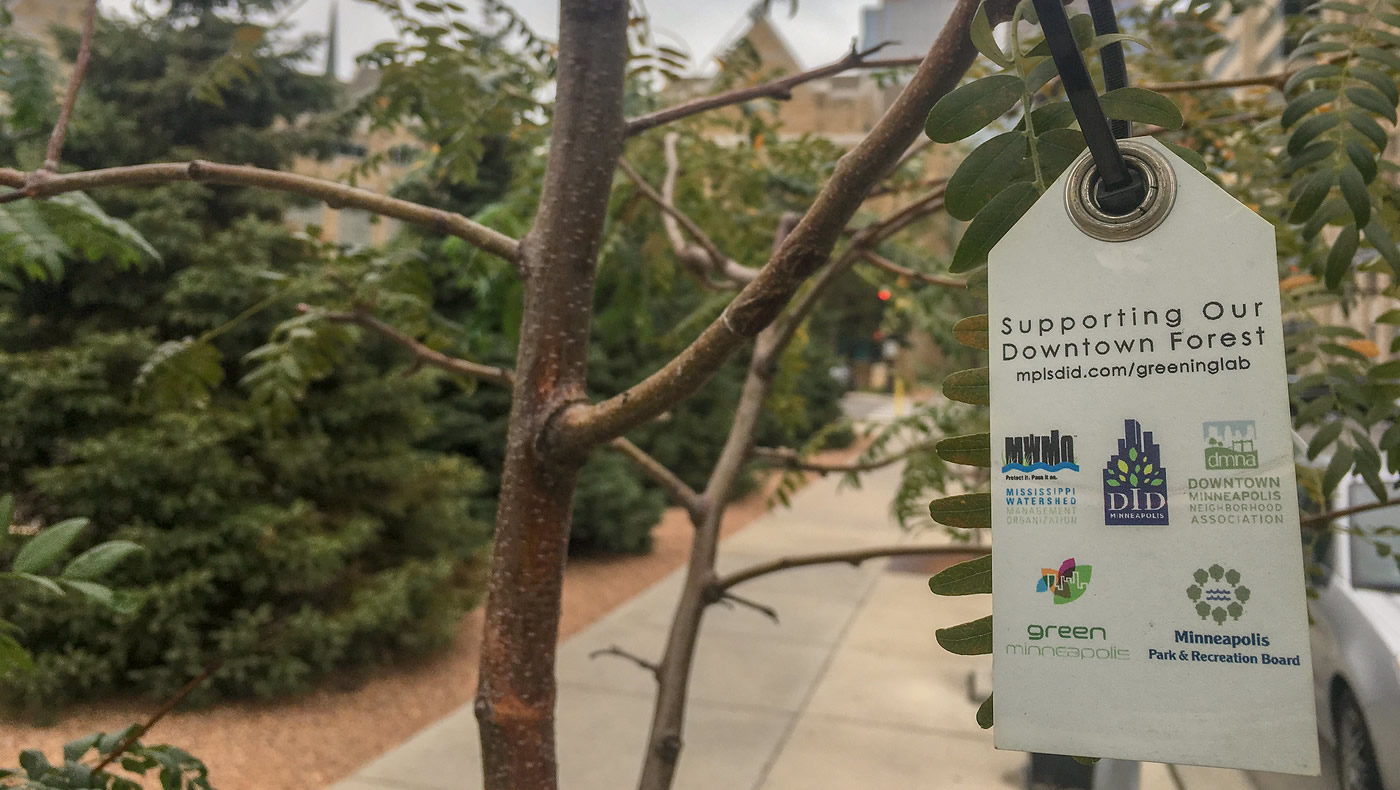
Finally, because the engineers shouldn’t have all the fun, MWMO has also been working with the DID and Greening Lab on some communications and outreach efforts. In 2017, we partnered with the DID to support development of a tree tagging program. As part of the program, they implemented a text-a-tree campaign to engage and educate the public about the value of trees in a downtown setting. A portion of MWMO’s funding went toward including information on the value of trees in stormwater management. From summer 2017 through fall of 2018, 485 trees were tagged in the downtown area and two hundred users participated in the text-a-tree program. Data collected showed that users were more interested in learning about the value of trees in stormwater management than any other topic.
The Downtown Runoff Study and planning and implementation of the South 8th Street stormwater planters are examples of how MWMO is partnering with organizations across the spectrum — from universities to businesses to our municipal partners — to use science and engineering to advance our organizational mission. That mission is to protect and improve the water quality in the Mississippi River. Keep your eye out for the South 8th Street stormwater planters and participate in the Greening Lab text-a-tree service when you’re downtown.


